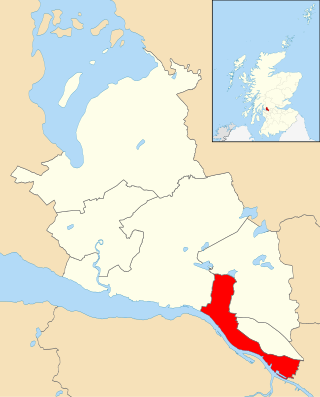
East Dunbartonshire is one of the 32 council areas of Scotland. It borders Glasgow City Council Area to the south, North Lanarkshire to the east, Stirling to the north, and West Dunbartonshire to the west. East Dunbartonshire contains many of the affluent areas north of Glasgow, including Bearsden, Milngavie, Milton of Campsie, Balmore, and Torrance, as well as many of Glasgow's commuter towns and villages. The council area covers parts of the historic counties of Dunbartonshire, Lanarkshire, and Stirlingshire.
Alan Reid is a Scottish Liberal Democrat politician who has been a councillor in the East Dunbartonshire ward of Bearsden North since 2022.

Bearsden is a town in East Dunbartonshire, Scotland, on the northwestern fringe of Greater Glasgow. Approximately 6 miles (10 km) from Glasgow City Centre, the town is effectively a suburb, and its housing development coincided with the 1863 introduction of a railway line. The town was named after Bearsden railway station, which was named after a nearby cottage.

Clydebank and Milngavie is a constituency of the Scottish Parliament covering part of the council areas of East Dunbartonshire and West Dunbartonshire. It elects one Member of the Scottish Parliament (MSP) by the first past the post method of election. It is also one of ten constituencies in the West Scotland electoral region, which elects seven additional members, in addition to the ten constituency MSPs, to produce a form of proportional representation for the region as a whole.

Eastwood is a constituency of the Scottish Parliament (Holyrood) covering part of the council area of East Renfrewshire. It elects one Member of the Scottish Parliament (MSP) by the first past the post method of election. It is also one of ten constituencies in the West Scotland electoral region, which elects seven additional members, in addition to the ten constituency MSPs, to produce a form of proportional representation for the region as a whole.

Strathkelvin and Bearsden is a constituency of the Scottish Parliament (Holyrood). It elects one Member of the Scottish Parliament (MSP) by the first past the post method of election. Also, however, it is one of ten constituencies in the West Scotland electoral region, which elects seven additional members, in addition to ten constituency MSPs, to produce a form of proportional representation for the region as a whole.

Drumchapel/Anniesland is one of the 23 wards of Glasgow City Council. Since its creation in 2007 it has retained the same boundaries and returned four council members, using the single transferable vote system.

Lomond is one of the six wards used to elect members of the West Dunbartonshire Council. It elects three Councillors.

Leven is one of the six wards used to elect members of the West Dunbartonshire Council. It elects four Councillors.

Dumbarton is one of the six wards used to elect members of the West Dunbartonshire Council. It elects four Councillors.

Kilpatrick is one of the six wards used to elect members of the West Dunbartonshire Council. It elects three Councillors.

Clydebank Central is one of the six wards used to elect members of the West Dunbartonshire Council. It elects four Councillors.

Clydebank Waterfront is one of the six wards used to elect members of the West Dunbartonshire Council. It elects four Councillors.

Renfrewshire is one of the 32 council areas of Scotland, formally established in 1996 to succeed the Renfrew district within the Strathclyde region, both of which were abolished; the headquarters are at Paisley.

Milngavie is one of the seven wards used to elect members of the East Dunbartonshire Council. It elects three Councillors. Its territory consists of the entire burgh of Milngavie, and a sparsely populated hinterland to its north-west, bordering the West Dunbartonshire and Stirling local authority areas. In 2020, the ward had a population of 13,572.

Bearsden North is one of the seven wards used to elect members of the East Dunbartonshire Council. It elects three Councillors. As its name suggests, its territory consists of the northern part of the burgh of Bearsden, with part of the boundary to the south following the path of the Antonine Wall; it also borders the Drumchapel housing estate in Glasgow – the marked differences in average life expectancy and other factors between residents living in close proximity in the two areas has been remarked upon in various studies. In 2020, the ward had a population of 14,943.

Bishopbriggs North and Campsie is one of the seven wards used to elect members of the East Dunbartonshire Council. It elects four Councillors.

Bishopbriggs South is one of the seven wards used to elect members of the East Dunbartonshire Council. Created in 2007, it elects three Councillors. As its name suggests, its territory consists of the southern part of the burgh of Bishopbriggs, bordering the city of Glasgow further south; following a 2017 boundary review, some streets in the west of the town were added from the Bishopbriggs North and Torrance ward, but the number of representatives did not change. In 2020, the ward had a population of 15,868.

Kirkintilloch East and North and Twechar is one of the seven wards used to elect members of the East Dunbartonshire Council. It elects three Councillors. The current entity was technically created in 2017 following a boundary review, but has largely the same boundaries as the 2007 Kirkintilloch East and Twechar ward, which as its name suggests encompassed the eastern parts of Kirkintilloch and the separate village of Twechar further east, up to the boundary with Kilsyth and Cumbernauld in North Lanarkshire.

Lenzie and Kirkintilloch South is one of the seven wards used to elect members of the East Dunbartonshire Council. It elects three Councillors. Its territory consists of the village of Lenzie including the modern development at Woodilee, plus the contiguous southern parts of Kirkintilloch. In 2020, the ward had a population of 13,475.



















